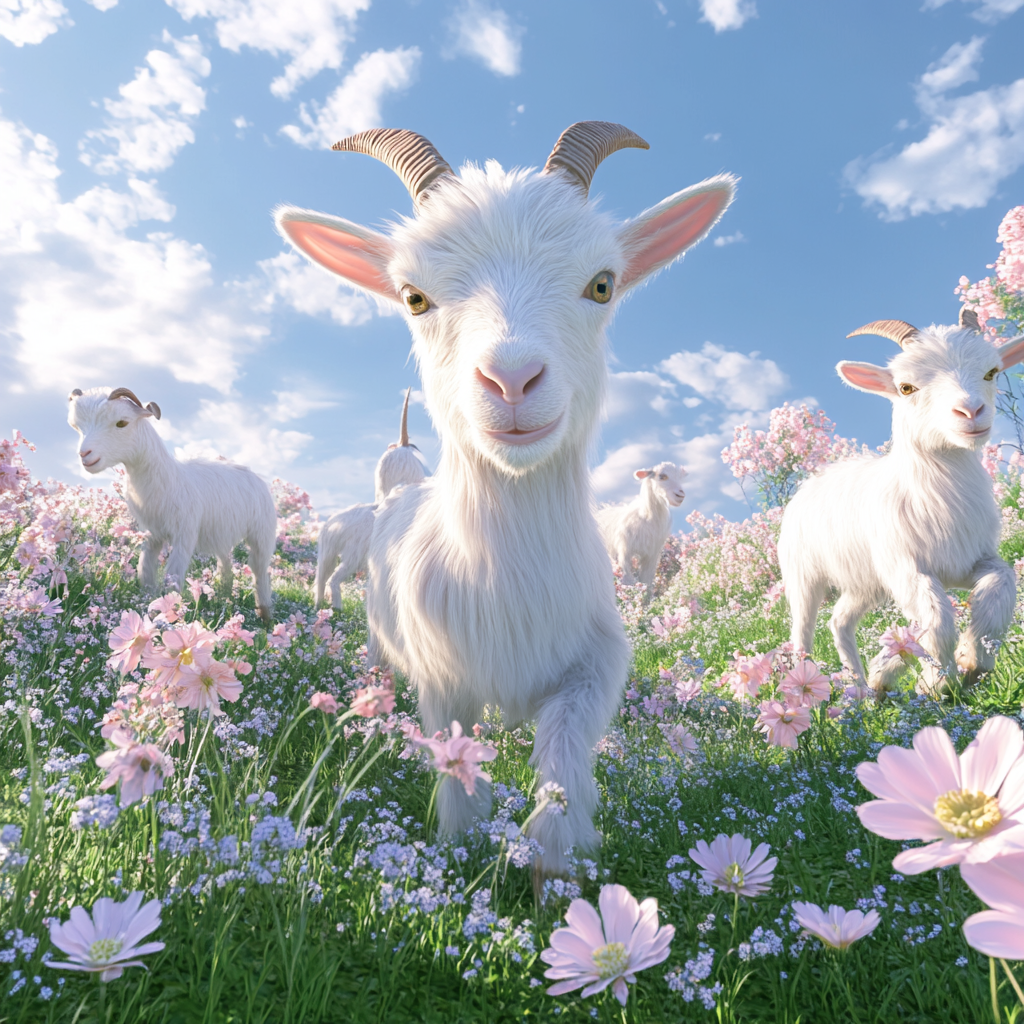Your cart is currently empty!

Beginner’s Guide to Raising Goats on a Small Homestead
🐐 Introduction
Thinking about getting goats? You’re in for an adventure. Goats are funny, feisty, and surprisingly helpful little farm animals. Whether you want milk, meat, or just natural lawnmowers with big personalities, goats are a popular choice for small homesteaders—and for good reason.
But before you run out and buy a pair of baby goats (and yes, you’ll need at least two), let’s talk about what you actually need to know to get started the right way.
1. Why Goats Make Great Homestead Animals
Goats are often called the “gateway animal” for homesteaders. They’re:
- Relatively small and easy to manage
- Social and entertaining to watch
- Great producers of milk, fiber, and meat
- Useful for land clearing (they’ll happily eat your brush and weeds)
They don’t take as much space or feed as cows, and their personalities make farm chores more fun (and a little chaotic).

2. What You Need Before Bringing Goats Home
Prep is everything. Here’s what to have ready:
- Shelter: A small barn, shed, or 3-sided shelter that keeps them dry and out of the wind.
- Secure fencing: At least 4-foot-high no-climb fencing (they will test it).
- Fresh water: A clean trough or bucket that won’t tip.
- Feeder: Something raised to keep hay off the ground.
- Companionship: Goats are herd animals. You need at least two. Never get just one—lonely goats become loud, stressed, and sometimes destructive. They do best when they have a goat friend to bond with.

3. Choosing the Right Goat Breed
Before you start looking at specific breeds, ask yourself: Why do you want goats in the first place? Your answer will determine the type of goat that best fits your homestead.
Here’s a breakdown based on your goals:
🥛 For Milk Production:
- Nigerian Dwarfs: Compact and adorable, they produce rich, high-butterfat milk.
- Alpines: Known for their steady, high-volume milk output.
- Nubians: Friendly and loud, with creamy, sweet milk.
📌 Related Resource: Watch this video to find out more about different dairy goat breeds.
🍖 For Meat Production:
- Boers: The most popular meat goat, known for fast growth and size.
- Kikos: Low-maintenance, parasite-resistant, and great for rugged terrain.
🌿 For Land Clearing (Brush Control):
- Spanish Goats: Hardy and adaptable, excellent for rough land and overgrowth.
- Mixed Breeds: Often more affordable and still effective brush-eaters.
🐐 For Companionship or Pets:
- Pygmy Goats: Small, playful, and great with kids (human and goat).
- Nigerian Dwarfs: Also a great option here due to their small size and sweet temperaments.
Choose the breed—or combination—that fits both your goals and your environment. Some people even mix breeds depending on what they want from their herd.
4. Does, Bucks, or Wethers: What Should You Get?
Once you’ve chosen a breed, the next question is: should you get does (females), bucks (intact males), or wethers (castrated males)? The answer depends on your goals and how involved you want to be in breeding.
Does
- Ideal if you want milk or plan to breed in the future.
- Can be bred annually and typically produce kids in the spring.
- Tend to be more independent and require more care during kidding and lactation.
Bucks
- Necessary if you’re breeding your own goats.
- Known for strong odor during rut (breeding season).
- Can be aggressive or unpredictable, especially during mating season.
- Best kept separate from does except during breeding.
📌 Related Resource: What you need to know before owning a buck (watch here)
Wethers
- Castrated males—gentle, easygoing, and great as companions.
- Perfect for land clearing, pets, or companion animals for does or other wethers.
- No smell or breeding behavior to manage.
Most beginners start with either a pair of does or a pair of wethers—depending on whether they want milk or just friendly, low-maintenance goats. If you want milk but aren’t ready for a buck, you can always breed your does at another farm.
5. Housing & Fencing: Don’t Skimp!
Goats are escape artists. If you don’t build it strong, they’ll find a way out—and maybe onto your porch roof.
Fencing Tips:
- Use welded wire or goat-specific fencing
- Avoid electric netting for long-term setups
- Add a hot wire along the top if needed
Shelter Tips:
- Dry and draft-free is key
- Add bedding (like straw or pine shavings) and clean it regularly
- Consider a separate area for kidding (baby goats) if breeding
5. Feeding & Nutrition
Goats aren’t garbage disposals! They can be picky eaters, despite the rumors.
- Hay: Your main feed—choose grass hay or alfalfa for dairy goats
- Grain: Only for pregnant, nursing, or growing goats
- Minerals: Free-choice goat-specific loose minerals are essential
- Water: Fresh and clean daily (they’ll refuse dirty water)
- Grass clippings: I also feed my goats fresh grass clippings and they do just fine. As long as the clippings are from untreated, chemical-free lawns and aren’t moldy or fermented, goats can enjoy them as a fresh snack.
- Tree branches and leaves: Goats love snacking on fresh or dried branches and leaves from safe trees. Many homesteaders even recycle their Christmas trees (as long as they’re untreated and not sprayed with chemicals) by giving them to their goats—pine needles are like goat candy!
Avoid feeding too many kitchen scraps or yard clippings from unknown sources—some plants are toxic!
6. Basic Health & Care
Healthy goats = happy goats.
Regular care includes:
- Hoof trimming every 4–6 weeks
- Deworming (check with your vet or local extension for schedule)
- Vaccinations (CD&T is a common one for beginners)
- Watch for signs of bloat, scours (diarrhea), or parasites
But health care goes beyond the basics. It’s important to understand the common illnesses and threats that goats can face so you can prevent problems before they start.
🐛 The Barber Pole Worm
One of the biggest threats to goats is the barber pole worm (Haemonchus contortus), a blood-sucking internal parasite that can cause severe anemia and even death if left untreated. It thrives in warm, humid environments and can spread rapidly through contaminated pastures.
To monitor your goats, learn how to perform FAMACHA scoring—a simple method of checking the lower eyelid color to detect anemia. Pale or white eyelids may indicate a heavy worm load and the need for deworming. You can get a FAMACHA chart from your vet or local extension office and should score your goats regularly, especially during peak worm season.

🦠 Other Common Goat Illnesses:
- Coccidiosis: A parasitic infection most common in young kids; causes diarrhea and weight loss.
- Bloat: Gas buildup in the rumen, often due to overeating grain or fresh legumes.
- Enterotoxemia: Also known as “overeating disease,” this is why CD&T vaccinations are so important.
- Respiratory issues: Can result from sudden weather changes, poor ventilation, or stress.
🩺 Proactive Care
As of recent regulatory changes, you can no longer purchase most antibiotics for livestock over the counter in the U.S. This means having a good relationship with a licensed farm vet is more important than ever. Your vet will not only be able to prescribe medication when needed but can also help you establish preventive care protocols tailored to your herd.
- Keep bedding clean and dry
- Rotate pastures to reduce parasite load
- Provide shelter from rain and wind
- Observe your goats daily for any changes in behavior, appetite, or appearance
Build a relationship with a farm vet—you’ll want help if a goat ever gets sick. Prevention and early detection are key to keeping your herd healthy and happy.
Healthy goats = happy goats.
Regular care includes:
- Hoof trimming every 4–6 weeks
- Deworming (check with your vet or local extension for schedule)
- Vaccinations (CD&T is a common one for beginners)
- Watch for signs of bloat, scours (diarrhea), or parasites
Build a relationship with a farm vet—you’ll want help if a goat ever gets sick.
📌 Related Resource: What’s in my goat medicine box (watch here)
7. The Downsides of Raising Goats
Goats are lovable, entertaining, and helpful—but they aren’t for everyone. Before you dive into goat ownership, it’s important to understand some of the challenges that come with them.
🧱 They Escape Everything
Goats are master escape artists. If your fencing isn’t solid and secure, they’ll find the weakness—and exploit it. They can climb, jump, and squeeze through spaces that seem impossible. It’s not uncommon to find a goat standing on top of a car, porch, or even your picnic table.
💸 They Can Be Expensive
While they’re often seen as a budget-friendly livestock option, goats do come with costs. Quality fencing, shelter, feed, minerals, bedding, and vet bills add up. If you’re breeding or milking, you’ll also need additional supplies and possibly specialized equipment.
🩺 They Get Sick Easily
Goats can go downhill quickly if something is off. Parasites like barber pole worms, coccidiosis in kids, and other common illnesses mean that health care is not optional. You’ll need to be proactive and learn how to spot issues early.
🐐 They Are Loud (Sometimes)
Some goats—especially certain breeds like Nubians—are extremely vocal. They’ll holler when they’re hungry, when they’re bored, or just because you stepped outside without saying hello. This can be charming… or not, depending on your setup and your neighbors.
🌱 They Destroy Plants
If it’s green and you love it, your goats probably will too. They can quickly decimate gardens, shrubs, and young trees if they get loose. Don’t expect them to respect landscaping or your prized rose bush.
💩 They’re Messy
Goats poop a lot. While the pellets are relatively easy to manage, their shelters need regular cleaning to prevent health issues. They also like to play with their food and will waste hay if feeders aren’t designed thoughtfully.
Despite the drawbacks, many homesteaders still choose goats because the rewards outweigh the challenges. But knowing the hard stuff ahead of time helps you make a more informed, confident decision.
8. Final Thoughts & Next Steps
Raising goats can be one of the most rewarding parts of homesteading—but it takes planning. Start with good fencing, the right breed, and a solid routine. You’ll learn a lot fast (goats have a way of teaching you lessons the hard way), but they’ll quickly become a beloved part of your farm life.
🐐 Conclusion
Goats are smart, sassy, and incredibly useful—but like everything in homesteading, they take work. If you’re dreaming of fresh milk, adorable babies, and a whole lot of personality, goats might be the perfect fit for your homestead.
📣 What’s Next?
Thinking about getting goats? Leave a comment with your biggest question—or tell me which breed you’re considering! And if you want more hands-on tips, subscribe to my weekly homestead newsletter right here 👇

Leave a Reply